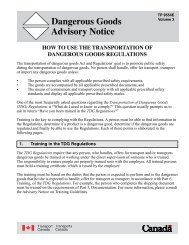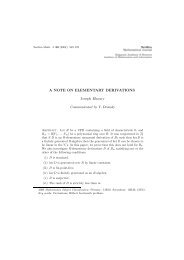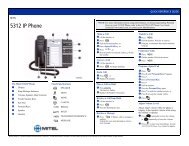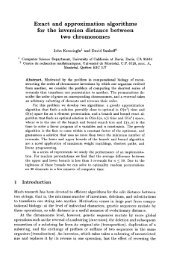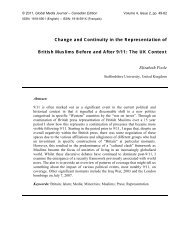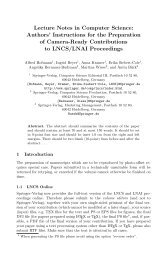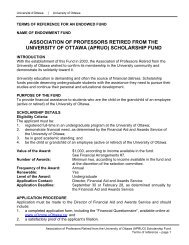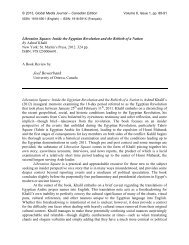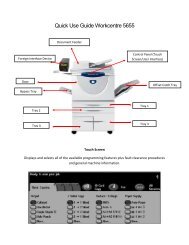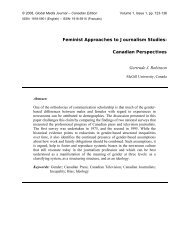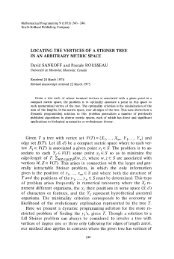PRACTICING PRECAUTION and ADAPTIVE MANAGEMENT ...
PRACTICING PRECAUTION and ADAPTIVE MANAGEMENT ...
PRACTICING PRECAUTION and ADAPTIVE MANAGEMENT ...
- No tags were found...
Create successful ePaper yourself
Turn your PDF publications into a flip-book with our unique Google optimized e-Paper software.
are that: (1) registration <strong>and</strong> re-evaluation decisions must be accompanied by an explicit <strong>and</strong>unambiguous statement of what are considered unacceptable effects arising from pesticide use;(2) there must be systematic monitoring of effects of product use, where <strong>and</strong> when they areapplied, <strong>and</strong> such monitoring must be designed in such a way as to maximize the detection ofunacceptable effects; (3) there must be regular reviews of previous decisions; (4) there must existthe statutory authority to revoke or amend previous decisions on re-evaluation; <strong>and</strong> (5) theremust be a systematic procedure for incorporating information from past decisions into currentevaluations. Our research indicates that while currently, conditions (3) <strong>and</strong> (4) are met,conditions (1) <strong>and</strong> (2) are not. Pesticide regulation in Canada will not, therefore, be trulyadaptive until regulatory decisions are formally treated as scientific hypotheses through thespecification of both acceptable <strong>and</strong> unacceptable effects; a systematic post-registration effects<strong>and</strong> exposure monitoring system is developed, including an appropriate electronic registry <strong>and</strong>database; <strong>and</strong> a clear, well-defined protocol is implemented whereby new scientific <strong>and</strong>regulatory information is systematically assimilated, assessed, <strong>and</strong> integrated directly into thedecision process in a timely fashion.Setting TACs in the 4X5Y cod <strong>and</strong> haddock fisheries.Dan E. LaneThis case study explores the practice of setting Total Allowable Catches (TACs) in AtlanticCanada <strong>and</strong> examines how precaution is practised in setting TACs for the groundfish stocks ofcod <strong>and</strong> haddock in the management area of southwest Nova Scotia <strong>and</strong> the Bay of Fundy(NAFO Divisions 4X <strong>and</strong> 5Y) in 2002 <strong>and</strong> 2003.The historical procedures of TAC-setting are presented including the changes that tookplace in recent years in reaction to the collapse of the Northern cod stock in 1992. In 1993, amore transparent process for recommending advice on TACs to the Minister of Fisheries <strong>and</strong>Oceans was inaugurated. This new process established an intermediary consultative groupknown as the Fisheries Resources Conservation Council (FRCC). The FRCC was a partnershipbetween government, the scientific community, <strong>and</strong> the stakeholders in the fishery. Its missionwas to review stock assessments contained in annual science-based Stock Status Reports (SSRs)together with other relevant information, <strong>and</strong> to recommend to the Minister TACs <strong>and</strong> otherconservation measures, including some idea of the level of risk <strong>and</strong> uncertainty associated withthese recommendations.The 2002 <strong>and</strong> 2003 TAC process - Cod experienced a small increase in estimated biomasssince 1999 however, the year-over-year increases were small <strong>and</strong> fishing mortality estimatesremained high despite restrictive quotas since the mid-1990s. In contrast, the estimates from thehaddock stock were highly optimistic-the haddock stock was estimated to be growing since 1990<strong>and</strong> estimates exceeded the stock thresholds. The “retrospective analysis” examined the fit of theVirtual Population Analysis (VPA) model to the data, <strong>and</strong> the “risk analysis” incorporated datavariability with the impact on the range of TAC values under expected exploitation rates. In 2002<strong>and</strong> 2003, both cod <strong>and</strong> haddock exhibited a “retrospective pattern” whereby biomass estimatestended to be over-estimates in the most recent year. The risk analyses for haddock in the 2002<strong>and</strong> 2003 exhibited steep curves indicating robust estimates. Risk analyses were not provided forcod, in either 2002 or 2003. In 2002, the Minister of Fisheries <strong>and</strong> Oceans decided that the‘status quo’ would be applied to the cod <strong>and</strong> haddock TACs compatible with the FRCCrecommendations. In 2003, the Minister adopted the FRCC recommendations for haddock <strong>and</strong>Executive Summary A-6



